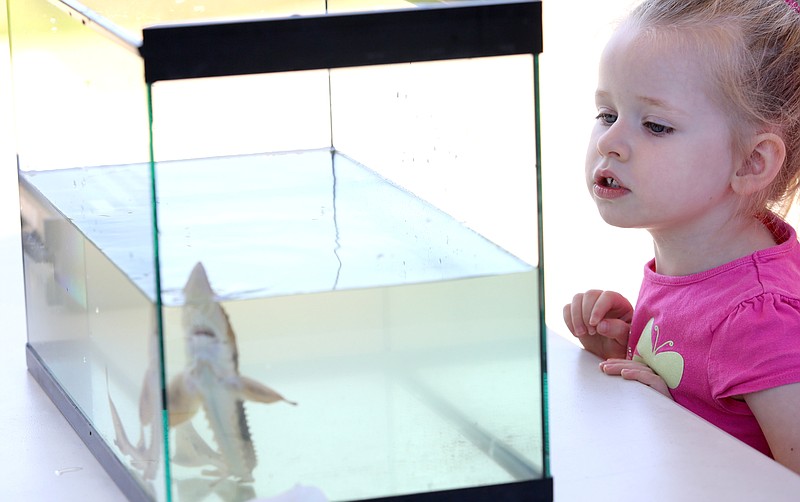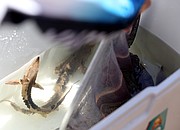A throng of spectators lined the boat ramp under the Market Street Bridge at the edge of Coolidge Park as onlookers watched from above, witnessing the reintroduction of the Tennessee River's largest fish on a hot spring day in Chattanooga.
A two-decade program to restore the lake sturgeon population is shifting to its final stages. The fish are preparing to spawn on their own in the wild for the first time since the population was eliminated in Tennessee in the late 1970s - meaning the program could come to an end over the next several years.
The Tennessee Lake Sturgeon Working Group project released its first sturgeon in 2000, reintroducing a species that had been destroyed due to habitat changes after the state's dams were built (overfishing and pollution were also a cause). To date, about 200,000 sturgeon have been released in the Tennessee River.
The final hurdle - natural spawning of a healthy population in the wild - remains, but could begin as soon as next year.
Lake sturgeon can grow to be 9 feet long and 276 pounds. They live up to 152 years. Male sturgeon don't reach sexual maturity until they are 15 or 20 years old, while females typically take between 20 and 33 years.
"There should be sexually mature males out there and [females] should reach that soon," Tennessee Aquarium Conservation Institute Science Program Manager Bernie Kuhajda said. " If fish do reproduce and larvae survive, then we'll be able to stop stocking, but there's a lot of stuff that has to go right."
Sturgeon spawn in shallow areas, thrashing with their dorsal fins and backs out of the water. Spawning fish will often float near shorelines where the water is shallowest. Subadults are known to make practice runs prior to releasing eggs. Fishermen reported seeing 5- to 7-foot-long fish in shallow water in May, leaving biologists hopeful the fish will soon spawn.
At that point, partners with the group will limit releases and continue to monitor the genetic makeup of the fish population. Wednesday's release near Coolidge Park could be one of the last public releases for the program.
"We feel like this is a success," TWRA assistant chief of fisheries Jason Henegar said. "We have fish close to maturity swimming in the rivers across the state. We're looking forward to natural reproduction of this species and getting that much closer to our goals of restoration."
Students from Chattanooga Girls Leadership Academy, Girls Preparatory School and a few McCallie School boys joined working group partners to help release a batch of 89 young sturgeon into the wild. The crowd grew as representatives with Major League Fishing and the San Diego Zoo - both in town for two unrelated events this week - joined to take part in the release. Passersby, intrigued by the spectacle, viewed from overhead, taking momentary breaks from their visits to the park to join the historic occasion.
"The girls got to help feed some of these sturgeon blood worms, and they've gotten a little attached to them," GPS teacher Katye Couch said. "So today is a bittersweet day for them. They named some of them and then get to release them today."
Traditionally, most fish released in the program are taken to remote areas east of Knoxville. Other small releases, like the one Wednesday afternoon, have been sprinkled across the region to give residents a chance to participate while serving as an educational tool.
Recently, University of Tennessee at Knoxville graduate student Todd Amacker found heavier, healthier fish in the Watts Bar Reservoir area. Through study, he determined there was more food availability in that area and near Fort Loudoun Dam near Lenoir City.
Biologists released fish in the new reintroduction areas last year, tracking the population's movement by inserting a small coded wire tag into the snout of the fish. The practice required the aquarium's conservation institute to hold the fish for several extra months, allowing them to grow twice as big to safely carry the tag. The fish released Wednesday were approximately 15 inches.
"[The tag] is the size of the lead on a mechanical pencil and really short, like a millimeter," Kuhajda said. "It's tiny, but it still is a hunk of metal."
TWRA will continue relying on fishermen to help monitor the fish. Anyone who finds or catches a sturgeon is asked to document and report the sighting to the state agency.
Pictures, date, location, length, weight and bait used are all helpful information, according to TWRA. Sightings and captures can be reported to iCaughtOne.org, by email to sturgeon.reports@tn.gov or by phone at 615-781-6575. Fishermen who catch a sturgeon receive a certificate. TWRA has received about 500 reports from fishermen.
Contact staff writer Mark Pace at mpace@timesfreepress.com or 423-757-6659. Follow him on Twitter @themarkpace and on Facebook at ChattanoogaOutdoorsTFP.

